Cost optimization in cloud environments is no longer a luxury — it’s a necessity. As businesses increasingly migrate to AWS, they are met with the difficult task of ensuring robust performance and scalability, all while keeping an eagle eye on costs.
How does one achieve this delicate balance? How can organizations ensure that their AWS architectures are both high-performing and cost-efficient? This article embarks on a journey through the world of AWS, shedding light on design patterns and best practices that serve as a beacon for those aiming to architect for cost.
Understanding AWS Pricing Models
At the heart of AWS cost optimization lies a deep understanding of its diverse pricing models. AWS offers three primary instance pricing options:
- On-Demand Instances – Ideal for short-term, sporadic workloads. These instances provide flexibility without any long-term commitments, allowing businesses to pay for compute capacity either by the hour or the second, based on instance type.
- Reserved Instances (RIs) – Tailored for predictable workloads, RIs let organizations reserve compute capacity for one to three years, offering significant discounts compared to On-Demand pricing. This commitment ensures both cost savings and capacity assurance.
- Spot Instances – These instances tap into unused EC2 computing capacity, offering substantial discounts. Best suited for workloads with flexible timing or those that can handle interruptions, Spot Instances provide an avenue for considerable cost savings.
Additionally, Savings Plans have emerged as a game-changer. By committing to a consistent amount of compute usage over a one to three-year term, users can achieve reductions of up to 72% compared to On-Demand pricing.
This commitment-based model offers flexibility across instance families, sizes, and regions, making it a strategic choice for economical organizations.
Design Patterns For Cost Optimization
Navigating through the intricate AWS pricing models is just the beginning. To truly architect for cost, businesses must also adopt specific design patterns that not only enhance performance but also drive cost efficiency.
Here are some useful patterns that can be adopted to keep costs low:
- Serverless Architectures – Embracing serverless patterns, like AWS Lambda, API Gateway, and DynamoDB, can significantly reduce operational overhead. By only paying for the compute time consumed, businesses can eliminate costs associated with idle resources, making serverless a go-to for cost-conscious architectures.
- Auto-Scaling And Elasticity – AWS’ EC2 Auto Scaling and Elastic Load Balancing tools are pivotal in ensuring resources align with demand. By dynamically adjusting resources based on traffic and load, over-provisioning is avoided, ensuring you only pay for what you use.
- Decoupling Components – Asynchronous processing, facilitated by services like SQS and SNS, allows for more flexible and cost-effective architectures. By reducing tightly coupled systems, businesses can achieve smoother scalability, better fault tolerance, and most importantly, more predictable costs.
Storage Optimization Strategies
Building economical architectures doesn’t stop at design patterns; it extends into how data is stored and managed.
Efficient storage strategies can significantly impact at the bottom line, especially dealing with vast amounts of data. The below are only a few examples of strategies that can be followed to optimize storage costs:
- Lifecycle Policies in S3 – By setting up policies to archive or delete unused or old data, businesses can ensure they aren’t paying for unnecessary storage. Tools like like Amazon S3’s lifecycle policies automate this process, moving data to cheaper storage classes like Infrequent Access or Glacier, or even purging it after a set period.
- Optimizing EBS Volumes – Every byte of counts. Selecting the right type of EBS volume based on workload requirements can lead to cost savings. Regularly cleaning up unused volumes and snapshots further ensures you’re not billed for redundant storage.
Data Transfer And Network Cost Reduction
Beyond storage, the way data moves within and outside of AWS plays a pivotal role in cost structures. Efficient data transfer and network strategies can prevent unexpected costs and ensure optimal performance. Here are a few tools and tips that can help achieve that:
- AWS Direct Connect – By establishing a dedicated network connection from your premises to AWS, Direct Connect can significantly reduce network costs, enhance bandwidth throughput, and provide a more consistent network experience than internet-based connections.
- Reducing Data Transfer Costs With Amazon CloudFront – Utilizing Amazon’s Content Deliver Network (CDN), CloudFront, can lead to faster content delivery to end-users and reduced costs. By caching content closer to the user, outbound data transfer costs can be minimized.
- Optimizing Inter-Region And Internet Data Transfers – Being mindful of data transfers between AWS regions and to the Internet is crucial. Strategies like consolidating resources in fewer regions and leveraging services like Amazon VPC Endpoints can help reduce these costs.
Rightsizing Resources
After addressing data transfer and network considerations, it’s essential to turn our attention to the very resource powering AWS deployments. Ensuring that these resources are appropriately sized is a cornerstone of economical AWS management. Think about the following the next time you’re designing your environment:
- Selecting The Right Instance Type – AWS offers a plethora of instance types tailored for different workloads. By choosing the most fitting instance type, organizations can ensure they’re not overpaying for unused capacity or under-provisioning and risking performance.
- AWS Computer Optimizer – This tool provides recommendations on optimal AWS resources for your workloads, helping to rightsize your deployments. By analyzing historical utilization of data, it suggests instance types and sizes that can lead to better performance and reduced costs.
- Periodic Review Of Resource Utilization – Regularly monitoring and analyzing resource usage ensure that deployments remain efficient over time. There are AWS tools, like Amazon Cloudwatch, and third-party tools, like CloudZero, that can assist in tracking utilization and identifying opportunities for rightsizing.
Leveraging CloudZero For Comprehensive AWS Cost Optimization
This article has focused on a wide range of tips and ideas to help cloud architects keep costs down, but we’ve yet to focus on the benefit that leveraging third-party platforms can provide. One of those platforms, CloudZero, stands out as a prime example, offering architects a comprehensive lens into AWS spending.
By delivering real-time insights across various facets of AWS, CloudZero can help ensure that you’re running on the right pricing model for your needs, or help guide you on what a change from the current model might save you.
Its advanced analytics can identify inefficiencies, such as over-provisioned resources or suboptimal data transfers, and provide actionable recommendations.
Regardless of where you are in the design process of your cloud environment, CloudZero serves as an invaluable ally. By integrating platforms like CloudZero, architects can ensure their AWS deployments strike the perfect balance between performance and cost.
Conclusion
Architecting with an emphasis on keeping costs low is both an art and a science. As businesses continue to embrace the cloud, the desire to strike a balance between performance, scalability and cost becomes imperative.
This article has illuminated the path, highlighting key AWS pricing models, design patterns, storage strategies, and data transfer considerations that can significantly influence cost structures.
Furthermore, the integration of third-party platforms like CloudZero underscores the importance of having a holistic view of AWS spending, ensuring that every architectural decision is not only performance-driven, but also cost-optimized.
As the cloud landscape continues to evolve, staying informed and proactive in cost management will be the linchpin for businesses aiming to harness the full potential of AWS without breaking the bank.








